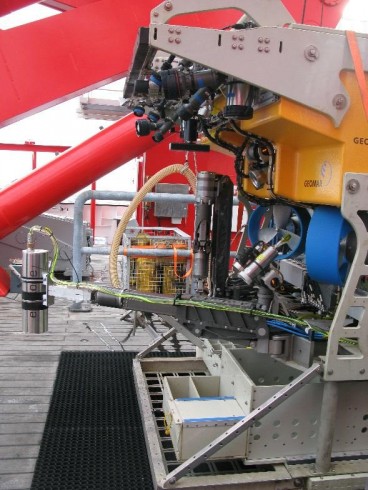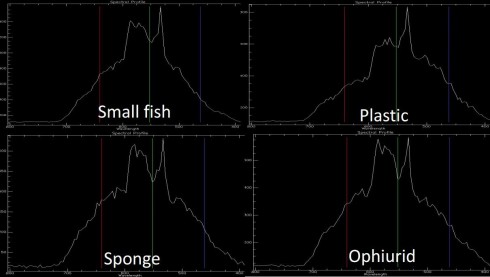Being able to test brand new technology is always exciting. The Ecotone Scientific UHI (Underwater Hyperspectral Imager) brought from NTNU in Norway was finished only a week before the Sonne disembarked from Guayaquil. It is the first UHI to be designed for deep sea use (6000m).
Any untested equipment will present some initial challenges. During the cruise, the UHI has become quite (in)famous for its weight. Due to the late delivery, shipping the equipment was unlikely to clear customs in time, and the whole system including adapters and topside computer had to be transported as checked in luggage. This, combined with KLMs 32 kg weight limit, did require a bit of creative packing involving both a kitchen weight and a calculator (“If one t-shirt weighs 180 grams, how many t-shirts can I use as protective padding for the camera housing without going over the weight limit?”). The end result was a new personal luggage record of 90 kg.
The sensor itself weighs 35 kg, and mounted on the end of the fully extended Rigmaster arm of the ROV (image left), this heavily (pun intended) influences the behaviour and capabilities of the ROV. Luckily we have a very helpful and skilled ROV-team on the ship, quickly able to adapt to new challenges.
So why go through all this trouble? What does a hyperspectral imager do, and what can we use it for?
Hyperspectral Vision
Like the human eye, a regular camera distinguishes between three different colours: Red, green and blue. The other colours we see is our brain interpreting the different levels of red, green and blue.
Some creatures have evolved a higher number of different colour receptive cone cells, with the Mantis Shrimp as the most advanced: Their 16 different cone cells allows them to distinguish between colours that look identical to us, and they can even see ultraviolet and polarized light.
A Hyperspectral Imager is a specialized camera with an even higher spectral (colour) resolution than the Mantis Shrimp. Each pixel recorded with such a camera contains a complete light spectrum, holding a lot of information that can be utilized by a computer later on. Hyperspectral imaging has been conducted successfully from airplanes and satellites for quite some time, but moving the technology underwater is only just starting.
The Ecotone Scientific UHI is a line scanner. While a regular camera records rectangular images, the UHI images are lines with a width of a single pixel. To produce a recognizable picture, the scanner needs to be moved forward at a steady speed, and the lines are then combined into a larger image in post-processing. The light of a line is sent through a diffraction grating to separate the different wavelengths of a pixel into up to 896 colour bands. Splitting the available light into so many bands does however require a lot of light, so in our experiment we recorded “only” 112 colour bands.
Recorded data
Some post-processing still remains before the real data interpretation can start. In order to determine the reflectance properties of what we’ve scanned, we first need to remove the effects introduced by the light sources and the absorption properties of the water. Nevertheless, we already see some of the distinguishing possibilities in the raw data.
The above image show the radiance spectrum recorded from four objects that all appear grey/white in the RGB-images (lines in the graphs show the wavelengths corresponding to RGB). Particularly in the case of plastic, we see a significant difference, and these “optical fingerprints” can be used for automatic classification by a computer.
Best,
Stein Nornes. NTNU

